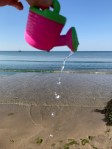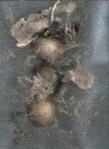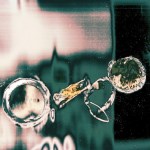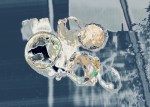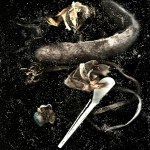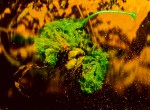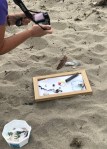Comparing and Contrasting
https://www.yascrawford.com/crj/considering-the-work-of-my-peers
Looking at the work of artists and photographers past and present is key to having some indication of where your emerging style might lie. What can seem very different on the surface can yield interesting similarities underneath depending on the factors and dimensions you look at.
Thus in her comparison with and admiration for the work of three peers also looking at health and wellbeing Yas Crawford additionally notes interesting contrasts but also some similarities, to my work, despite it’s focus on inorganic matter, following her visit to my exhibition.
In addition to Yas’s points about control, it’s apparent loss in respect of health and having it but not using it in relation to littering beaches, I wonder if there are other continuum we can relate to. For example, would images about health resonate more strongly with an audience than mine about debris? Maybe so. Where they will converge in emotional impact of course is when there is significant evidence that the debris in our oceans and on our beaches is not only harming wildlife and the environment but also ourselves. Thus the control we once had and chose not to use will have been taken out of our hands.

Reference
LOEILDELAPHOTOGRAPHIE [written by]. 2017. ‘Jeremy Carroll. Marine Pollution’. loeildelaphotographie. [online]. Available at: http://www.loeildelaphotographie.com/en/2017/02/25/article/159939624/jeremy-carroll-marine-pollution/ [accessed 23/7/17].
Reflections on my exhibition and the work of Jo Dennis
Jo Dennis’s work is of interest to me in a number of ways. She photographs well-used and deteriorating spaces, incorporates painting and creates installations. I also photograph man-made things, albeit on a much smaller scale, and create images and have just added an installation with my exhibition 17-24th August 2018. We both look at deterioration and erosion and ‘reframe’ what we see.
“The images of the walls become ‘found’ abstract paintings – in turn, the works become a record of the time that has eroded these surfaces and reveal the domestic, un-fantastic banality of everyday existence. For Dennis there is a poetic profundity to this erosion. Her composition and cropping of photographs, allied to her paintings and sculpture, together expand these ideas using a process of abstracting and reframing imagery.” (Sid Motion Gallery 2017)
Her multi-image multi-surfaces installation is brought together using painted lines that appear on some of the images thereby making a physical connection tying the collection to a singular theme.

When I view her work I am struck immediately by her use of limited colour palettes and the consistency in the aspect ratios and sizing of individual and small group images which bring the subsets of the series together.



In contrast I feel my work is still at a messy experimental stage, each piece having its own life, contrasting and sometimes clashing colours and shape and size being determined by what most suits the subject matter rather than what might make looking at the images easier.


Although I divided my images into three types placing each on a separate wall of my exhibition there remained a certain higgledy piggledy feel about each one. Clearly I need to address these areas, not simply to feel I am ‘conforming’ to unwritten rules of consistency and continuity that date back to analogue times (e.g. Cotton 2018: 219-221) but because I want to find a way to maximise the receiving of the narrative I tell through my images.
References
Cotton, Charlotte. 2018. The Photograph as Contemporary Art. 3rd edn. London: Thames & Hudson.
JOBEY, Liz. Lost and found- the transformative art of Jo Dennis. Financial Times: Financial Times Photography. 18 May 2018. Available at: https://www.ft.com/content/c2316412-5894-11e8-b8b2-d6ceb45fa9d0 [accessed 23-08-18].
SID MOTION GALLERY. Jo Dennis Matter out of Place. 19 January – 24 February 2017. Available at: https://www.sidmotiongallery.co.uk/exhibitions/jo-dennis-matter-out-of-place/ [accessed 23-08-18].
Paul Kenny
I have just been made aware, through a friend who has visited my exhibition this week, of Paul Kenny and his publication ‘Seaworks 1998-2013’ available from TripleKite Publishers. What a great reference in relation to my project.
For more than 35 years Paul has sought “the awe-inspiring in that which is easily passed by. It contains issues of fragility, beauty and transience in the landscape: marks and scars left by man and the potential threat to the few remaining areas of wilderness. Looking at the micro and thinking about the macro, I aim for each print to be a beautiful, irresistible, thought provoking object.”
His aim is so similar to mine. However, whereas I am focussing on taking debris on beaches he is collecting organic as well as inorganic items on beaches. Another similarity is his methodology. I am just starting my adventure with no camera techniques, particularly scanning. Paul creates plates of his found items, scans and then creates large scale photographs with them (Huxley-Parlour 2018). He has also used seawater from the beaches where he took images to erode and change their appearance (Seymour, 2016).
I am so pleased that my images created a resonance with my friend who recommended Paul’s work to me. I plan to find out much more as I move into the Final Major Project stage of the MA Photography. The first step is to find and borrow a copy of ‘Seaworks 1998-2013’ as it is out of stock on several sites.
References
HUXLEY-PARLOUR ARTISTS. Available at: https://huxleyparlour.com/artists/paul-kenny/ [accessed 23-08-2018].
KENNY, Paul. Available at: http://www.paul-kenny.co.uk/ [accessed 23-08-2018].
SEYMOUR, Tom. 2016. Paul Kenny’s Land and Sea. British Journal of Photography. 21 June 2016. Available at: http://www.bjp-online.com/2016/06/paul-kennys-land-and-sea/ [accessed 23-08-2018].
TRIPLEKITE PUBLISHING. Available at: http://www.triplekite.co.uk [accessed 23-08-2018].
Oral Presentation Surfaces and Strategies Module MA Photography Falmouth University
WIP Portfolio Surfaces and Strategies Module
Showing now!
 Beauty and the Beach… opened yesterday with a lovely soiree and will run until 24th August. Also on line at Landings 2918 http://www.landings.space for a year.
Beauty and the Beach… opened yesterday with a lovely soiree and will run until 24th August. Also on line at Landings 2918 http://www.landings.space for a year.
My 10 tips on mounting an exhibition ( which may be obvious to some but could also be helpful to others):
1. Think about potential audience(s). The context for mine is a three sided ‘booth’, one of several displaying the work of artists, in a working artist’s studio that also serves the community as a shop, post office and cafe. Based on the diversity of local and tourist custom in this area I included a range of images from seascapes to ‘abstracted beach debris’.
2. Consider how the images are displayed. I selected three groups to be placed on each of three walls: seascapes and finds that clearly identify what the subjects are, beach finds that start to intrigue through use of light, textures and tonal range and beach finds that have varying degrees of digital darkroom work and need closer viewing to understand what they are and how they were made (camera, scanner and cyanotype).
3. Decide what else to include. Products: I made products on varying surfaces to see how my images might look on glass, china, in acrylic, on hessian and towelling fabric. Incorporated into the exhibition of images as an ‘installation’ these have added interest and potentially value at several levels. In addition to encouraging a ‘double take’ and potentially enhanced impact between image on the wall and the product where the image has been presented in the two forms, they can strengthen the message you wish to convey, show a different perspective (e.g. ‘recycling’) and present items considered aesthetically pleasing and an object of discussion in their own right. Props: In addition to newly created products I included props to ‘set the scene’ reinforcing both raising awareness of beach debris and to show original items that featured in some of the images.
4. Prepare images and products well in advance in time for faults to be addressed, particularly if dependent on others (e.g. for printing and making products).
5. In the weeks leading up to the opening plan, discuss, shape and confirm arrangements for publicity, financial transactions, opening event and hospitality, and whether you need to be present during opening times or whether the event is ‘hosted’ by another on your behalf.
6. Develop a hanging plan according to the options available at the location and be prepared to adapt according to circumstances on the day.
7. Allow for doubling and even tripling your initial estimation of the time setting up will take.
8. Have an assistant for practical and moral support when setting up.
9. Expect the unexpected. Opinions, likes and dislike vary according to many factors, nature, nurture, life experiences and importantly neurological sensory and emotional sensitivity. As authors of ‘images’, having lived with and become very familiar with them over time, our attachments can be quite different to the response and relationship others form with an image.
10. Keep energy and wellbeing levels up during setting up and opening days and enjoy showing your work to others!



Draft work in progress portfolio 2
My Paradigm has Shifted
This week a tutor noted that I had made a ‘paradigm shift’ in my photographic work. My immediate feeling was one of excitement as if it was a positive accolade which was swiftly followed by thoughts of why, what, how and whatever it is others are seeing in my work, can I keep it up? It certainly is not related to the technical prowess in producing images that are not blurry in parts or whole, that conform to rules of thirds or Phi, that tell a story and feel contained within the frame etc. However, linking together recent comments in webinars from tutors and colleagues and family and friends there is something about my recent images that apparently ‘intrigues’ others and entices them to look for more than a few seconds seeking decoding and explaining as their eyes and brains run through algorithmic processes in deciphering what is in front of them. But what is a paradigm shift and is it inherently a good thing? Two defining explanations I found helped me to realise what I have been doing in the past few weeks.
Cambridge Dictionary.:
“…a time when the usual and accepted way of doing or thinking about something changes completely.”
Wikipedia. Philosophical Investigations:
“Seeing that vs. seeing as
In addition to ambiguous sentences, Wittgenstein discussed figures that can be seen and understood in two different ways. Often one can see something in a straightforward way — seeing that it is a rabbit, perhaps. But, at other times, one notices a particular aspect — seeing it as something.”

“The duck-rabbit, made famous by Wittgenstein”
Subconsciously I have abandoned rules and experimented more freely than ever before with image production inspired by course activities and playful literature (Higgins 2013; Fulford and Halpern 2014; Antonini, Minniti et al. 2015). I think what I have been doing is moving from ‘seeing that’ (i.e. spotting and depicting rubbish on the beach which everyone quickly recognises) to ‘seeing as’, thereby becoming aware of other ways of considering what I am looking at.
References
ANTONINI, Marco, MINNITI, Sergio, GOMEZ, Francisco, LUNGARELLA, Gabriele and BENDANDI, Luca. 2015. Experimental Photography: A Handbook of Techniques. London: Thames & Hudson.
Cambridge Dictionary. Available at: https://dictionary.cambridge.org/dictionary/english/paradigm-shift [accessed 12-08-2018].
FULFORD, Jason and HALPERN, Gregory (Eds.). 2014. The Photographer’s Playbook. New York: Aperture.
HIGGINS, Jackie. 2013. Why It Does Not Have To Be In Focus: Modern Photography Explained. London: Thames & Hudson.
Wikipedia. Philosophical Investigations. Available at: https://en.wikipedia.org/wiki/Philosophical_Investigations [accessed 12-08-2018].
From Landscapes to Nurdles Workshop 8-8-2018
Despite the publicity being late for the workshops (due to circumstances beyond my control) I had two enquiries about the second one. I contacted them and one person was available this week. Fortuitously the weather held and although we did not manage the lowest tide due to other commitments, it had just turned when we arrived. I like to catch the tide about an hour before its lowest point as what remains on the sea bed can be quite interesting just as the debris infested sea weed is on the highest point. However the purpose was not to pursue my project work about debris on beaches but rather how to take land and seascapes and ways of capturing small items such as nurdles on the beach. I tailored some of the images in the handout as well as the suggested competitions based on our pre-workshop chat and my knowledge of what the person was interested in; gardening and wildlife.
From Landscapes to Nurdles workshop
I prepared a what to bring and expect information sheet as well as a handout. The former was and the meeting arrangements were confirmed by email. On meeting we parked at the beach carpark and an expectations form was completed. This was used to have a discussion about what they hoped to get out of the session followed by a look at their camera and mobile phone and discussion about the controls. Reference was made to the handout, particularly the contents referring to exposure and composition. I should at this point out that on this occasion the participant is a friend who did genuinely want to advice on improving their image taking and had hardly used the phone to take photographs. They were interested in learning more about my project work as well. So in terms of getting to know someone and establishing honesty and trust between us before we set off for the beach….it was already present.
With people I have not met before I would be careful to find out more about them beforehand and have a longer introductory session before venturing down to the beach, particularly if working alone with a stranger in what can be a relatively isolated place depending on time of day. Thus thinking about potential risks as well as health and safety events is really important. We both carried water and I took a first aid kit in my bag the contents of which are displayed.

We agreed to cover one beach that is river estuary-side and then a linked second one facing the English channel. In all we spent 2.5 hours on the beaches, walking and talking about ways of photographing scenes and small items at our feet. I had taken a few things to experiment with; an empty photo frame, a crystal ball, tissue, tracing and ordinary paper and kitchen foil. I also took a very small set of three lenses for use with a mobile phone; wide angle, macro and fish eye. These were all enormously helpful and fun to play with as well as focussing our discussions about the use of light and composition, reflecting the contents of the handout I had made. We also had success with nurdle hunting while being watched with curiosity by all the holiday makers.
Sarah Newton From Landscapes to Nurdles Workshop, 2018
The session concluded with a coffee and cake at the location. I sent my images of them for their approval and this came with a completed feedback sheet and some of the images they had taken during the workshop.
“Did it meet your expectations?
Yes, it did – and more. Lots of hints for the camera settings, which was very helpful to me. Very interesting to learn about the rule of thirds – it makes you think much more before just clicking the button! Also, thinking outside the box – not just “pretty” pictures, but using items that are lying around.
What would you have liked less of?
I think the balance was just right, between theory and practice.
What would you like more of?
Again, I think it was well balanced – I particularly liked exploring the use of different lenses, as well as other objects to make a more interesting photo. Also, I haven’t used the camera on my phone very much, so this was a useful addition to the morning.”
I had not realised until I prepared the what to expect and handout sheets that I did know a fair bit and could talk to someone else about photography and my chosen project. This was reinforced during the workshop when I found myself spontaneously offering information and advice without reference to the handout. I still do not know enough to be able to answer very technical questions but this activity proved to me that I know enough to make a workshop interesting, informative and fun. I thoroughly enjoyed myself as did my friend who communicated with me directly and on the feedback form.

